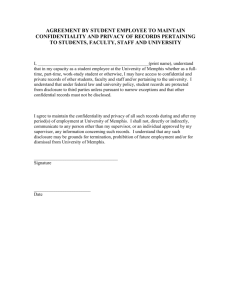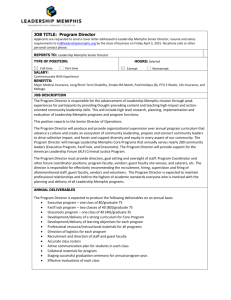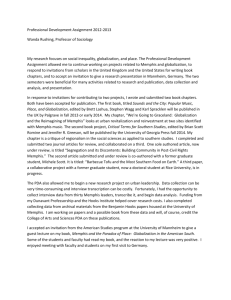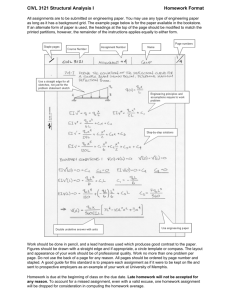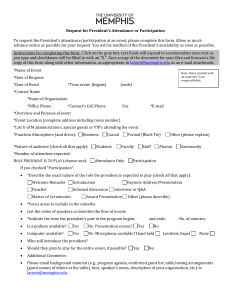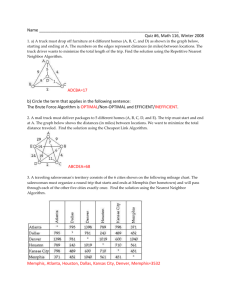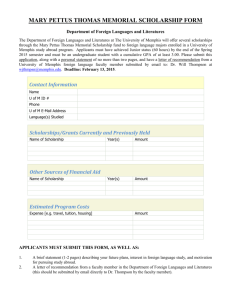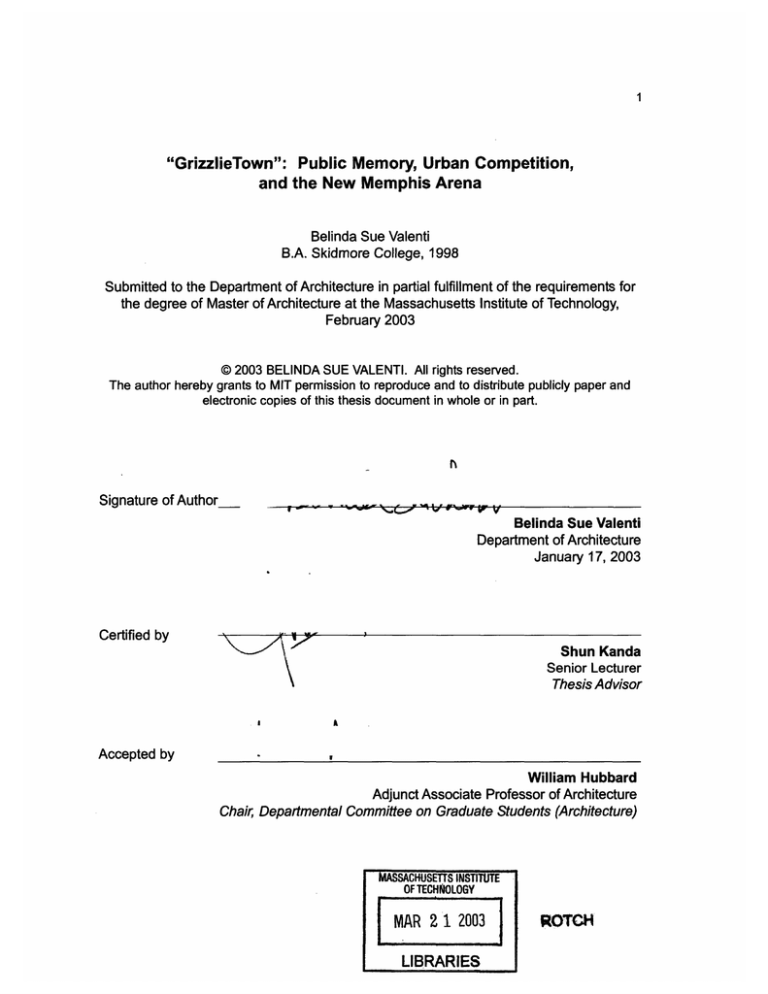
"GrizzlieTown": Public Memory, Urban Competition,
and the New Memphis Arena
Belinda Sue Valenti
B.A. Skidmore College, 1998
Submitted to the Department of Architecture in partial fulfillment of the requirements for
the degree of Master of Architecture at the Massachusetts Institute of Technology,
February 2003
@2003 BELINDA SUE VALENTI. All rights reserved.
The author hereby grants to MIT permission to reproduce and to distribute publicly paper and
electronic copies of this thesis document in whole or in part.
Signature of Author
Belinda Sue Valenti
Department of Architecture
January 17, 2003
Certified by
Shun Kanda
Senior Lecturer
Thesis Advisor
-
,
Accepted by
William Hubbard
Adjunct Associate Professor of Architecture
Chair, Departmental Committee on Graduate Students (Architecture)
MASSACHUSETTS INSTITUTE
OF TECHNOLOGY
MAR 2 1 2003
LIBRARIES
ROTCH
Acknowledgments
I would like to thank Shun Kanda, Carol Burns and Margaret Crawford for their helpful
criticism and encouragement. I thank my peers, especially Leonardo Bonanni, Eddie
Chiu-Fai Can and Noah Luken for their help over the course of the project. I give a
special thanks to Jeff Kessler for his contributions and support. This book is dedicated
to my parents, Pete and Sue Valenti, and my brother, Frank Valenti.
Thank you to the following people and organizations who kindly provided much helpful
information:
Ellerbe Becket, Inc.
George E. Hardin
Looney Ricks Kiss
Memphis Center City Commission
Memphis Shelby County Room
Memphis and Shelby County Archives
Emily Passini, New Pathways, Inc.
Thesis Committee:
Shun Kanda, Thesis Advisor
Senior Lecturer
Carol Burns, Reader
Visiting Associate Professor of Architecture
Margaret Crawford, Reader
Professor of Urban Design and Planning Theory
Harvard Graduate School of Design
Abstract
"GrizzlieTown": Public Memory, Urban Competition, and the New Memphis Arena
Belinda Sue Valenti
Submitted to the Department of Architecture in partial fulfillment of the requirements for
the degree of Master of Architecture at the Massachusetts Institute of Technology,
February 2003
Many cities struggle to compete for revenue and the promise of future growth by building
new entertainment complexes downtown, and in doing so make spatial compromises in
the effort to get ahead. Urban Competition should be used to its fullest urban and
architectural advantage in order to best serve a city's multiple publics. Memphis, a city
with a rich cultural heritage, has recently decided to build a new indoor NBA basketball
arena. As its design suggests, this big-box facility will fall short in its potential for invigorating downtown spaces and will result in a loss of public memory. The publicly-funded
and privately-owned arena will be largely inaccessible to the taxpayers who have chosen
to fund it. Here, an alternate proposal for a downtown sports arena includes an urban
strategy, the reconfiguration of a sports arena seating bowl, two mixed-use buildings, a
sports and entertainment building, and an open-air public space that enriches public
memory of the site. Such a design draws upon a city's history while taking advantage of
opportunities for urban growth.
Thesis Advisor: Shun Kanda, Senior Lecturer
fig. 1.Aerial view of Downtown Memphis
Table of Contents
Introduction
6
Impressions and Facts
9
Urban Competition in Memphis
13
Urban Strategy and the New Memphis Arena
23
Public Memory and Its Locations
29
Final Design Concepts
35
Final Design Proposal
43
Conclusion
67
Bibliography
69
Appendices
71
Except where noted, all the images in this thesis were produced by the
author. See Bibliography for Figure Sources.
Introduction
The impetus for this project came from a
visit to Memphis a couple years ago during
a summer roadtrip. In the June heat I
stood on Beale Street watching tourists
walk by, and I was struck with the sense
that changes were quickly happening in
Memphis. I hardly knew Memphis; I had
never been there before and I did not know
anyone who lived in Memphis. I did not
know whether the city was undertaking
renewal campaigns or whether people had
plans to build anything new downtown.
The only things I had known about the city
were in relation to Elvis Presley, the blues,
and the history of the Civil Rights Movement in the United States.
As I stood there looking at buildings being
torn down, I began trying to answer questions about the past and urban future of
Memphis. The more impressionistic side
of what I felt at the time was that Memphis
was in a mid-life crisis of sorts. Like a
work of art in progress, I sensed emerging
agendas being played out physically in the
city's downtown. Ideas about memory in
architecture came to mind as I tried to
recall a history of events in the city that
could have resulted in what I saw.
This experience in Memphis became an
opportunity to investigate a set of urban
observations that I had wondered about,
but had never confronted from a design
perspective. These issues included
whether cities in the United States could
successfully revive their downtowns by
building shopping and entertainment
facilities, how American-style architectural
preservation creates nostalgic atmospheres, how pedestrians confront vehicle
traffic in downtown, why development
chooses some sites in a city and not the
others, and whether the post-industrial
fig. 2. View of Beale Street, north side between Second and Third Streets
futures of many downtowns in the US,
especially those in the Midwest, is bleak.
I took these impressionistic observations
and set out on an investigation that uncovered more than it resolved. This thesis
yielded a set of urban and architectural
responses to many of the observations I
had made a couple years ago. The following thesis book illustrates the issues most
important to me, the process by which I
investigated, and the design responses I
made.
The general result of the thesis is a greater
understanding that the meaning of public
urban space in the contemporary American
city can be enriched by looking at historical
significance while looking forward, thinking
about how cities should employ a strategic
approach toward their own futures.
fig. 3. (above) Memphis Central Business Improvement District.
8
Impressions and Facts
fig. 4. View from Linden St. toward north
Impressions and Facts
Impressions
The cultural center of Memphis is Beale
Street, located at the southern border of
downtown. When I visited, I found that I
gravitated toward Beale Street naturally this is where both the tourists and the
locals are. The people on Beale Street are
there for people-watching, they hang out in
bars and they buy beer from vendors on
the sidewalks.
Many of the buildings on Beale Street are
mere storefronts that have been preserved
from the late nineteenth century. All of the
buildings are brick and are about three or
four stories high. Beale Street is comprised of bars and restaurants with a few
office spaces in upper-level floors. Along a
two-block length, the buildings are on the
National Register of Historic Places, and
people seem to know this as they stroll
figs. 5, 6. Views of area just south of Beale Street
back and forth looking up at the brick
facades. The character of Beale feels like
Bourbon Street in New Orleans.
Just off of Beale Street is a sea of empty
lots, many of which are used as surface
parking lots. The contrast between onBeale and off-Beale is striking visually; a
visitor has a clear understanding of where
he is supposed to be because of Beale
Street's neon lights, outdoor patios, and
audible Blues music. Beale Street is
clearly the destination in downtown.
The loose impressions I got when standing
in this area were related to physical
changes that I saw as being a threat to
Memphis' heritage and history. Through
images in my mind and images I saw
reproduced on signs seen on Beale, I
naively jumped to conclusions about how
specific events of the past had left visible
effects in the physical fabric of the city. In
my mind at the time, it made sense that
riots associated with the American Civil
Rights Movement had left traces and signs
in the urban fabric that I saw before me.
Over the course of this project I have
discovered that this conclusion is almost
entirely false, except for the idea that
memory can exist in architectural form as
some sort of deeper, almost spiritual
meaning.
zlies. The city had recently enticed the
team to move to Memphis from their
previous home in Vancouver with the
promise of a new indoor arena. A part of
the deal was that the city would build the
arena downtown and the Grizzlies would
eventually own it. Currently the New
Memphis Arena is under construction and
is scheduled to finish for the 2004 season.
Facts
One of the facts that I quickly learned
during my visit was that on a site just south
of Beale Street the city was building the
"New Memphis Arena". Slated to occupy a
better part of the vacant lots between
Beale and Linden Streets would soon be
an indoor sports arena, the future home of
NBA basketball team, the Memphis Griz-
fig. 7. View of Beale Street: south side between Second and Third Streets
12
Urban Competition in Memphis
fig. 8. Map of downtown Memphis indicating available parking spaces
construction site for the New Memphis Arena indicated in grey
fig. 9. View toward north from Linden Street,
a wall of downtown buildings moves toward the south
Urban Competition
The reason why Memphis has decided to
build a new arena is Urban Competition.
The city needs to compete for revenue and
the promise of future growth. In all instances, Urban Competition presents an
opportunity for cities to enrich their own
spaces.
Development is clearly uneven in downtown where the tourist is priority. Private
indoor entertainment complexes proliferate
in Memphis, resulting in an insufficient
quality of indoor and outdoor spaces for
the city's multiple publics to enjoy.
Taxpayers often help to pay for the new
entertainment complexes, yet not all of the
taxpayers have access to them. Most of
the people who can gain entrance to these
entertainment facilities do not live downtown. Conversely, most of the people who
will be living downtown next door to the
New Memphis Arena cannot afford to go to
games.
The reality of Memphis is that it is a shrinking city with a declining population and a
faltering economy. Memphis could use to
its benefit a new capital project like an
arena to best serve its multiple publics.
The sports arena's multiple publics are: the
city, local residents, people who go to
games (many of whom live out of town),
and the financiers. What seems to be the
case is that the publicly-funded sports
facility will benefit only a few of its multiple
publics, which becomes a missed opportunity.
The challenge for the architect is to treat
the opportunities given by Urban Competition with a more strategic approach.
fig. 10. Panorama of construction site for the New Memphis Arena,
an area just south of Beale Street
-the Pyramid sports
arena
- convention center
-
performing
arts center
-
pedestrian zone
-
minor league
baseball park
. Peabody Center,
door shopping mall
fig. 11. Major entertainment facilities in downtown.
All but one were built within the past 5 years
-
Beale Street
-
Gibson Guitar
Factory
Entertainment facilities: "filling-in" downtown
Over the past five years, Memphis has
acquired five new entertainment complexes in downtown. This is in addition to
the Pyramid, an indoor sports arena built
twenty years ago that is currently obsolete
because of its insufficient number of luxury
boxes.
in every instance. The practice of "fillingin"the city's voids results in the interiorization of the urban lifeblood, outdoor
public and pedestrian activity.
A trend in Memphis' development is to
target and "fill-in" empty spaces in downtown with facilities that will serve as attractions for out-of-town tourists. Many of
these facilities are "big box" in character;
often they are large buildings with a single
interior grand space. In order to make way
for such a large facility, (a facility with a
large building footprint) there is typically a
process of land acquisition and consolidation, which is the case in Memphis.
Because Memphis is a shrinking city, it
does not make spatial sense to fill-in voids
fig. 12. (above) The Pyramid sports arena in downtown Memphis
fig. 13. (below) The Gibson Guitar Factory, located just south of Beale Street
fig. 14. "Frontier" of growth in downtown Memphis; the area currently has several vacant lots
Frontier of growth
The border between Memphis' dense
urban fabric and its less dense, faltering
one is the development "Frontier". This is
located just to the south of Beale Street
and is recognized by its stark emptiness.
This desolate part of the city appears to
want buildings to come there. The emptiness is bound by the Gibson Guitar Factory to the North, the vacant Chisca Hotel
to the west, scattered industrial buildings
to the south, and two churches to the east.
Emphasizing the vacant lots are the two
churches, St. Patrick's and the AME
Baptist Church (Clayborn Temple). These
two churches appear as if they are the only
people standing in an area that used to be
filled with a crowd. Set slightly up on a
sloping hill, they are holding their ground
from the encroaching parking lots.
fig. 15. View towards north of downtown from St. Patrick's Church
middle-income to high-income units
public housing units
fig. 16. Residential areas in downtown, arena site indicated in grey
Residential neighborhoods in Downtown
The number of people who live downtown
Memphis is incredibly small in relation to
the metropolitan area. During the postwar
years, "white flight" occurred in Memphis
as it did in many other cities in the United
States. Most people who live in the metropolitan area of Memphis actually live in the
suburban communities to the east of
downtown.
The majority of the people who live downtown are the urban poor, although there is
a growing trend to develop mid-income
and high-income housing units near the
riverfront in downtown. Zip code 38126 is
located directly adjacent to the site that the
New Memphis Arena will occupy. This is
statistically one of the economically poorest zip codes in the country. The median
income of residents in this zip code is
$6,000 annually.
On a recent visit to Memphis, I talked to
the director of MIFA, the community development corporation working in this area of
downtown. She predicted that federal
funding cuts in the department of Housing
and Urban Development will likely be
responsible for ejecting any remaining
poor residents out of downtown. With the
HUD HOPE VI initiative, most residents of
public housing have been relocated to
areas outside the central business district
to the southeast.
fig. 17. View of the churchyard south of St. Patrick's Church
22
LIIIZJ
1111V 1LFL1111752
lobby, concessions, bars,
restaurants, circulation
-(---------r1F7 ---
fig. 18. (above) Site plan diagram of New Memphis Arena
(below) Site section diagram of New Memphis Arena, showing stratifications
The New Memphis Arena as Found-Object
The diagrams to the left show the actual
design of what will be built in Memphis on
a site just south of Beale Street. Early in
the project I gathered information about
the design from the arena's architect. As a
starting point for design, I took the seating
bowl as a found-object in the city. An initial
move that I made was to take away the
ancillary functions and spaces from around
the seating bowl and leave the bowl in its
given location.
The sports facility will be used for basketball on about forty-five evenings per year.
Other events that could occur in the arena
include rock concerts and college basketball games. Incidentally, in Memphis there
are already two usable arenas for college
teams, including the Pyramid and a football stadium located east of downtown.
Given the system of Urban Competition,
and given the architectural challenge of
designing a sports entertainment facility,
the challenge for the urbanist/architect is
to employ a strategy through design that
uses Urban Competition to a city's best
advantage. In other words, the problem
that Urban Competition presents to the
designer is to forge a spatially symbiotic
relationship between a new entertainment
complex and its multiple publics.
The knowledge that Memphis is building a
new indoor sports arena appeared as a
challenge for me to question the urban and
architectural opportunity that such a facility
would bring to Memphis. The arena under
construction in Memphis is a missed
opportunity to provide multiple publics with
a publicly accessible facility. In very simple
terms, it occurred to me that if taxpayers
would fund a sports and recreation facility,
then they should be able to enjoy it.
Mississippi River
existing parking facilities,
(in yellow)
arena seating bowl
"scattered" arena facilities
fig. 19. Urban Strategy: scatter parking and program, spilling activity into the city
....
.......
...
.......
....
..
:
Scatter: Parking and Program
As an urban strategy, I have taken the
program requirements of the arena under
construction and have re-situated them in
the city with the goal of creating a more
symbiotic relationship between the facility
and the city's multiple publics.
One of the problems, or missed opportunities, in the design of the New Memphis
Arena is that the scheme is based on a
closed interior space that is inaccessible to
the general public. Further, all of the
activities taking place inside the arena will
not spill into the city. A better solution
would be to first take advantage of necessary facilities that already exist in the city.
In this case, there is plenty of parking in
downtown Memphis in the form of surface
lots and parking garages that could be
used on the forty-five nights per year when
there will be home games.
'I,
A related opportunity missed in the given
design was the potential of creating outdoor public spaces in the city. I have
proposed that the arena program (aside
from parking), plus additional program, be
used to create an outdoor public space in
front of the arena seating bowl.
(See Appendix B, Urban Strategy: Extrapolation)
-
ML
figs. 20, 21, 22. (above and below left and right)
concept sketches of "spilling" activity in to the city
section sketches show how the spaces below the edge of the seating bowl meet the context
..........
28
....
.....
.....
Public Memory and its Locations
fig. 23. Photo from the funeral of Dr. Martin Luther King, Jr.
on Hemando St. at Clayborn Temple
Hernando
Street
Sanitation Workers'
March Route
the New Memphis
Arena,
currently under
construction
iME Baptist Church,
Clayborn Temple
fig. 24. Arena site diagram showing the route of the Sanitation Workers' March in 1968
An Erasure of Public Memory
The arena under construction is located
precisely on the site of the Sanitation
Workers' March that took place in 1968.
This was a public demonstration that
involved an estimated 15,000 people.
Demonstrators convened at the AME
Baptist Church, called Claybom Temple at
the time, and walked north on Hernando
Street, west on Beale, and north on Main
Street to the City Hall. Dr. Martin Luther
King, Jr. led the march that is considered
an important success in the American Civil
Rights Movement. The march preceded
the death of King who was assassinated in
Memphis just four days after the march.
When the New Memphis Arena is completed, there will be an erasure of public
memory in the city. Not only will the arena
facility erase the memory of a specific
event, but it will also erase the memory of
a public street. Hernando Street used to
continue from north of Beale Street to
south of Linden Street.
fig. 25. Photo from the Sanitation Workers' March, also known as the "/AMA MAN" march
figs. 26, 27, 28, 29. (top) a section of the 1951 Sanborn map
showing the New Memphis Arena site
(bott. left) buildings, (bott. middle) lot lines, (bott. right) open spaces
Urban Landscape Memory: a look at the 1951 Sanborn
In thinking about spatial change and
continuity in Memphis, I looked at a 1951
Sanborn Insurance map of downtown. I
chose the 1951 map because it showed
what the urban fabric was like prior to
Urban Renewal during the 1970's. The
map, to the left, shows that downtown
generally had a smaller scale urban fabric.
The site of the future New Memphis Arena
used to have on it residential and industrial
buildings.
One important discovery that I made in
looking at the map was that the Gayoso
Bayou, which appears as a small stream,
used to run through part of the site and on
adjacent sites. After discovering this, I
remembered seeing this small bit of water
recently, only that it had been buried
approximately ten feet underground and
under parking lots on Linden Street. As
part of my proposal, I included restoring
the Bayou, which has been hidden since
1951, but still exists in the landscape. This
operation restores an urban landscape
memory.
The studies at the bottom of the left page
show separations of buildings, lot lines,
and open spaces on the New Arena site
taken from the Sanborn map.
34
...
.......
......
.........
.I..:
...
....
....
Final Design Concepts
fig. 30. Sketch diagram of the proposed arena concept,
yellow indicates massing on the site used to create a public open space
Beale Street
arena seating bowl
en-air public space
facade
Gibson Guitar Factory
fig. 31, 32. (above) Early concept sketch of open-air public space
(below) Design concept model. Red indicates the public open space
Original model scale: 1/64"=1 '-0"
.......
..
..
..
....
..
.....
"GrizzlieTown" Design Concept
The final "GrizzlieTown" proposal developed from the urban strategy of scattering
the arena program into the city. By borrowing the program requirements included
in the design of the New Memphis Arena,
the concept of the GrizzlieTown proposal is
to form a symbiotic relationship between a
public sports facility and its multiple publics.
the urban space. These are: the proposed
fagade on the arena seating bowl, the
fagade of the Gibson Guitar Factory, and
two proposed facades located perpendicular to the seating bowl.
3. Surfaces, each representing public
open-air activities, create a ground-plane in
the middle of the open-air public space.
(See Appendix A: Architectural Studies)
Basic Interventions:
1.An open-air public space is positioned in
relation to adjacent urban spaces in the
city, taking advantage of the potential for
activity to spill out of the arena seating
bowl. This open-air space connects to the
existing pedestrian-only public street, Beale
Street.
2. Proposed building facades help to form
fig. 33. Design concept viewed from the south
fig. 34. Diagram with streets re-instated (red) and bowl chopped off (yellow)
Initial moves: Public Streets and Ways, intersection between bowl and city
The design concept assumes:
1. Re-instate streets and ways that would
otherwise have been "erased" by the New
Memphis Arena. This includes Hernando
Street and a section of Lt. George Lee Way
to the west of the seating bowl.
2. The shell structure of the seating bowl
proposed in the design of the New Memphis Arena will "remain" in the exact location in which it will be constructed (the
seating bowl will be used as a foundobject). The seating bowl dimensions and
materials proposed in the New Memphis
Arena design will be used in the
GrizzlieTown proposal, although the interior
of the seating bowl will be re-designed.
3. The seating bowl will be "chopped" off
along Hernando Street to yield right-of-way
to the street.
4. A glass-enclosed space will be inserted
into the section of the seating bowl where it
has been chopped off.
The design scope includes:
1. the open-air public space located directly in front of the seating bowl along
Hernando Street
2. two mixed-use buildings located on the
north side of the public space
3. a sports and recreation center located on
the south side of the public space
4. the outdoor spaces around the exterior of
the seating bowl
5. the interior design of the seating bowl
with respect to the circulation
fig. 35. Photo collage showing pedestrian and vehicle connections to Beale Street
...
........
..
1.
1-1, ""I,
......
Pedestrian Connections to Beale
Except for morning delivery traffic, Beale
Street is closed to vehicles, allowing the
street to become entirely overrun by pedestrians. The space of Beale Street is made
of thin storefront facades, and would allow
pedestrians to move in a north-south
direction through Beale Street.
space design was to take advantage of
Beale Street pedestrian activities and make
connections from the north to south sides
of Beale. Small pedestrian passages
already exist between adjacent buildings
that front on Beale Street. The
GrizzlieTown proposal takes advantage of
these small pedestrian ways.
A strategy for the GrizzlieTown public
W7~
" Lt
0!
two
fig. 36. Plan diagram of Beale Street with existing pedestrian passages marked in red
......
......
...
42
43
V
4.'
Final Design Proposal
fig. 37. Night sketch of the MIT athletic fields from the Charles River Esplanade
fig. 38. Lot Lines taken from the 1951 Sanborn superimposed with existing buildings in 2002
Original scale: 1"=100'
Proposal for a Changing Urban Structure
By superimposing the lot lines on the site
in 1951 with the existing buildings, I tried to
understand the ways in which the fabric of
the city has changed over time. This
analysis yielded an urban stance that the
project took; urban landscape memory can
act as an influence on strategic future
development (see pages 32-33 on Urban
Landscape Memory.)
This proposal suggests that urban structure elements, such as historic lot lines
could, and should have an influence on the
future structure. This is not to say that the
1951 property lot lines should be the
overriding urban structure for all future
development, but more as way of looking
for contextual influences on a changing
urban structure.
46
/lieZ~i
EK
CZ
0
~Ua
I
7LTj-l 1
FL,
i
0q
._/,
fig. 39. Urban Plan of "Grizzlie Town" proposal with a build-out scenario for the future
Original Scale: V'= 100'
Urban Plan 2050
In this urban plan, the blue color represents existing buildings and yellow represents a potential build-out scenario for
2050. The GrizzlieTown proposal is imagined in future scenarios.
This plan suggests a way of thinking about
how Memphis, as a shrinking city, could
develop in the future. This thinking proposes that future growth in these existing
vacant lots be reserved and measured as
compared to the normal trend of constantly
filling-in vacant lots. This thesis argues
that filling-in all empty lots in all cases is
strategically bad because shrinking cities
cannot maintain the need for an increasing
amount of available space in downtown
buildings.
48
Sel Aley
Grizzlie Way
JB
01
6
Linden St.
e
L
A
fig. 40. "Grizzlie Town" Ground-Floor Level Plan
Original scale: 1/32"=1 '-0"
"GrizzlieTown" Ground Floor Level Plan
The proposal includes:
1. Open-Air Public Recreation Space with
Play Surfaces
1a. Artificial illumination under glass
between Play Surfaces
6. Grizzlies Team Entrance and surface
parking lot
7. Re-naming of Lt. George Lee Way to
"Grizzlie Way"
2. Sports and Recreation Center with
outdoor below-grade basketball courts
3. Two Mixed-Use Buildings with outdoor
mini-courtyard connection to Beale Alley
4. Sanitation Workers' Commemorative
Park
5. Design of Arena fagade and circulation
of arena seating bowl
fig. 41. Close-Up Plan of Open-Air Public Space
in front of the Seating Bowl Facade
50
fig. 42. Section A: North-South
Original Scale: 1/32"=1 '-0"
fig. 43. Section B: East-West
Original scale: 1/32"=1 '-0"
GrizzlieTown Final Proposal Model
fig. 44. Final model of proposal viewed from the south,
Original scale of model: 1/32"=1 '-0"
fig. 45. Grizzlie Town proposal viewed from the southwest
"GrizzlieTown" Scenarios
The GrizzlieTown proposal is an urban
entertainment and recreation venue located in downtown Memphis that contains
indoor and outdoor sports facilities, two
mixed-use buildings, exclusive parking
spaces, and a park commemorating Civil
Rights Movement events that took place in
Memphis. It is owned and operated by the
Memphis Grizzlies NBA basketball team.
A game-day scenario: game-goers would
come to downtown, park their car at a
location within a quarter-mile from
GrizzlieTown, would walk to GrizzlieTown
on a route that takes them down Beale
Street and into the open-air public space,
would enter into the sports arena through
its large glass fagade, and finally would
emerge out into the city from exits pointing
outward in all directions from the circular
seating bowl.
On non-event days and nights,
GrizzlieTown would serve as urban recreation spaces for Memphians.
fig. 46. View through connection to Beale Alley, looking at sports and recreation center
fig. 47. View of Seating Bowl facade from Open-Air Public Space
fig. 48. View of Open-Air Public Space from above Beale Street
fig. 49. View of Grizzile Town proposal from above the Gibson Guitar Factory
fig. 50. View of Grizzlie Town at pedestrian's view level
at the intersection of Grizzlie Way and Third Street
fig. 51. Night view of Grizzlie Town from the southwest corner
fig. 52. Night view from the west
A Glowing Space in the City
figs. 53, 54. View from southwest corner
66
Conclusion
Urban Competition can and should be
used to produce spaces beneficial to cities
and their multiple publics. The arena
currently under construction in Memphis
fails to regard the public memory of the
site, the established patterns of public
passage through the city, and the city's
desire to become alive with activity. As an
alternative approach, the design proposal
presented here allows for a spatial invigoration of the city while using the city's past
to inform a direction for future growth.
The languages of urban and architectural
design explored in the project lie somewhere between typical landscape, urban
and architectural design approaches. For
instance, this investigation found that by
employing a vocabulary of landscape
design in an open-air public space, the
goal to incorporate a public urban memory
into the project was realized. This combi-
nation of design approaches allowed the
project to respond to the particular urban
culture found in Memphis while acknowledging that many of these issues are
global.
The project has revealed some tools
necessary for architects to be critical of
spatial practices. One of these tools is to
quickly identify a system or systems within
which a practitioner can be most effective.
For example, an early challenge in this
project was to think of Urban Competition
as a host of opportunities, as opposed to a
system that needs to be changed. Another
example is the skill of investigating urban
problems in a way that is productive, which
in the case of this project, was to think
historically in order to form strategies for
the future.
A future direction for this project would be
to suggest more generally what approach
shrinking cities like Memphis should take.
This suggests that there is an approach to
be found, requiring a careful balance to be
struck between the desire for urban
growth, the reality that the city is shrinking,
and the effect growth will have on a city's
multiple publics.
Bibliography
Beifuss, Joan Turner. At the river I stand: Memphis, the 1968 Strike, and Martin Luther
King. Brooklyn: Carlson Pub., 1989, c1985.
Boyer, M. Christine. "The Great Frame-Up: Fantastic Appearances in Contemporary
Spatial Politics," Spatial Practices. edited by Helen Liggett and David C. Perry. Thousand
Oaks, CA: Sage, 1995.
Eco, Umberto. Travels in Hyperreality. San Diego: Harcourt Brace, 1986.
Fogelson, Robert. Downtown - It's Rise and Fall, 1880-1950. New Haven: Yale Univ.
Press., 2001.
Hayden, Dolores. The Power of Place: Urban Landscapes as Public History. Cambridge: MIT Press, 1997, c1995.
Holcomb, B. "Revisioning Place: De- and Reconstructing the Image of the Industrial
City," Selling Places: The City as Cultural Capital, Past and Present, edited by Gerry
Kearns and Chris Philo. London: Pergamon Press, 1993.
Lowenthal, David. The Past is a Foreign Country. Cambridge: Cambridge Univ. Press,
1985.
Rossi, Aldo. The Architecture of the City. Cambridge: MIT Press, 1982.
Sorkin, Michael, ed. Variations on a Themepark: The New American City and the End of
Public Space. New York: Hill and Wang, 1992.
Zukin, Sharon. The Cultures of Cities. Cambridge: Blackwell, 1996.
Illustrations
fig. 25: from The Commercial Appeal, / Am A Man. Memphis, TN: Memphis Publishing
Co., 1993.
All other illustrations were produced by the author.
70
Appendix A
Architectural Studies
fig. a. Massing model from south
Original model scale: 1/64"=1'-0"
Distribute program to create an urban space
As part of a series of massing studies, this
sketch model shows a square footage of
600,000 sf. This is an equivalent amount
of space to that provided in the design of
the New Memphis Arena. I attempted to
create an outdoor public space on the west
side of the seating bowl.
fig. b, c. (top) Concept sketch of public open space in red, and connections to adjacent streets
(bottom) model from west
fig. d. massing model of lanscape scheme
Landscape and Urban Voids
This massing approach was about using a
landscape approach toward creating open
spaces on the arena site that
complimented open spaces on adjacent
lots in the city. I looked at ways of shaping
the mass on the site for providing outdoor
recreation spaces.
fig. e. yellow indicates adjacent urban voids
Hernando St et
fig. f. massing diagram viewed from the south along Hernando Street
An extroverted urban stance
This diagram explores the operation of
making incisions into the mass on the site
in order to create proportions in the landscape. I combined this with a previous
idea about taking a complimentary approach toward adjacent vacant lots near
the site.
Incisions in the ground radiate out from the
proposed massing on the site. These
vectors suggest the directions in which
circulation would occur.
fig. g. View from the west
78
Appendix B
Urban Strategy: Extrapolation
fig. h. Design concept including satellite pavilions, indicated in red
Extrapolation: Scatter program at an urban scale
A tangential direction for the design was a
scheme that would use linkages to fund
satellite pavilions in downtown residential
neighborhoods. Two pavilions are indicated here in red - one is a commercial
building that would contain the Grizzlies'
team offices, and the second is a miniature
sports center located in a residential
neighborhood south of the arena site.

